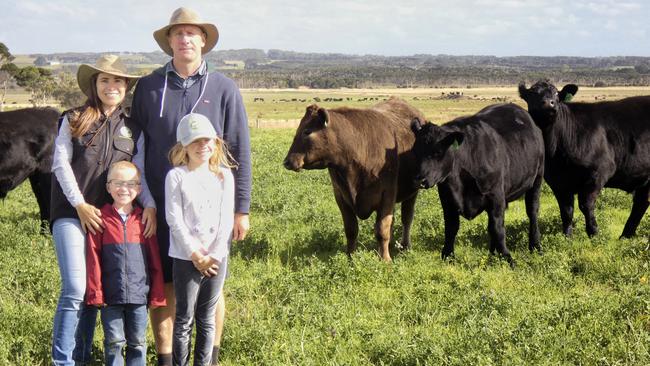This healthy herd is fit for a King
This King Island beef farming family aims for high turnovers from a low-cost and low-input base.

WHEN visitors to King Island book a tour of Ana Pimenta and Tom Perry’s 810ha farm there’s one question most ask.
“People arrive on the island and want to know how come there’s 100,000 cows across a 100,000ha slice of land,” Ana said of the Meat Your Beef tours.
“They want to know where food comes from, and what makes good meat.”
The couple, who both have considerable academic and practical agricultural training, happily explain.
“This is a low-cost, low- input and efficient, but high turnover farm,” Tom said.
Added Ana: “The secret to this business is we don’t over-complicate, keep things simple, but at the same time keep informed. We don’t always do what every agronomist or fertiliser expert tells us.
“Most of all, we don’t compromise on animal health or welfare.”
The proof is in their figures.
For two years they have not had an Meat Standards Australia downgrade, “which is unheard of”, maintaining a 99 per cent compliance figure, “which we believe is because we give them as much human contact as we can, so we don’t need bikes or dogs”.
Cattle have an “exceptional” pregnancy testing rate of 95 per cent “because we believe in keeping them on a good level of nutrition at joining”.
From 40-year-old pastures, during winter/spring steers gain 2kg per day, with the couple focused on healthy soil biology, not using pesticides, occasionally spot herbicides and targeted fertilisers.
GROW FOR IT
SINCE 2009 the couple have run Gado Management, using “planned risk”, starting with a small mob of 30 cattle on leased land, and through slow and steady investment have now grown that to 2000 mostly Angus, at full stocking rate, including 750 breeders.
The 810ha is spread across four properties, including 100ha of leased land, with the couple hoping to expand further.
“King Island has become a very popular place. We now have a lot of climate refugees from Queensland and land prices have gone up and is now tightly held, so we’ll have to wait for opportunities,” Tom said.
Most of their cattle are sent to Greenham in Tasmania, for their Cape Grim brand, including steers about 18-20 months, or up to 600kg, and cull heifers at 20-24 months or 550kg.
Steers to 450kg are sold to finishers and feedlots in Tasmania or on the mainland.
Greenham also sends a small portion back to the farm, which Ana gives in lunches to Meat Your Beef tour guests.
There are about three tours a week, about 90 minutes long, and with between two and 25 guests; the farm also has accommodation.
SOLID GROUNDING
ANA, 37, and Tom, 38, agreed their farm philosophy was based on early training.
Ana was born in Portugal and studied livestock production, before taking a six- month agricultural exchange to King Island in 2008, when she met Tom.
She then expanded her knowledge, becoming an MSA grader at the island’s abattoir, where “I learnt to translate genetics and meat quality and consistency”.
Ana worked as a sustainable agriculture facilitator for the island’s Natural Resource Management group, where she now volunteers, alongside other committee work including King Island Beef Producers Group and Cradle Coast Natural Resource Management Committee.
“The beef group is all about making our beef industry stronger. For example since the island’s abattoir closed in 2012 we’ve been working to launch a new one, which was meant to start building last summer,” she said.
“Animal welfare, freight costs and logistics are also always on the radar.”
HIGH STEAKS
TOM grew up on a beef farm on King Island, studied agriculture in Hobart and won an Angus Australia scholarship in 2004 to study the US beef industry, later completing his masters in agriculture at the University of New England.
Because the couple started from a zero base, their growth has focused on “planned risk” with forward budgets planned using worst case scenarios, including beef prices 10 per cent lower than the current market.
They bought land with established Angus herds and have since expanded the genetics with bulls from Landfall Angus in Tasmania and Hicks Beef at Holbrook in NSW, aiming for a moderate birth weight, 400-day growth and positive fat figures, balancing “carcass figures with visual”.
“We always keep to a budget when buying bulls,” Ana said.
“Where some farmers pick just three bulls to buy we will select 30 but buy just three, keeping to about $5000.”
The mob is joined in November and entirely grass-fed, the farm only occasionally buying in supplementary hay, at most 80 bales.
RENOVATION RUMBLE
ABOUT 180ha of the farm is unproductive coastal country, and rotational grazing — based on seasonal variation — sees an average 22 dry-sheep equivalents per hectare, adapting stocking rates to seasons.
The couple renovate only a small portion of pasture annually, about 10ha, focused on ryegrass, clover and fescue.
Tom said the key to productive pastures was the application of 150kg/ha of nitrogen pasture booster blend, and a foliar spray of 85ml/ha of gibberellic acid.
“Economically, that’s better than the cost of renovating pastures,” he said. “These are 40-year-old pastures with weeds, not productive, but the fertiliser application ensures during winter and spring steers gain 2kg a day.”
While there are disadvantages to farming on a remote island, King Island’s advantage is its almost guaranteed average annual rainfall of 850mm.
“We had one of our best ever seasons in 2019. It was a dry winter, which was good and it rained when we needed it through spring and summer,” Tom said.
Ana said while she was more focused on animal welfare and being a “green farmer”, Tom was production-focused.
“But it balances out,” she said. “We don’t always agree, our views are not always the same, but we always talk it through and come up with the best solution.”


